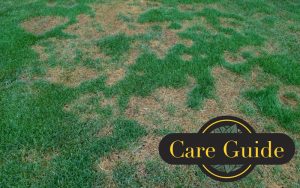
Large Patch Turf Disease
Click Here to view or download this guide as a PDF.
Large Patch is a fungal disease of warm season grasses such as St. Augustinegrass, centipedegrass, sea-shore paspalum, zoysiagrass and Bermudagrass, appearing as a circular or irregular patch of yellow or brown turf. The fungus is present in the soil and thatch layer year-round, but the disease shows only under specific environmental conditions. Symptoms develop when nighttime temperatures are between 60 and 75°, daytime temperatures are below 85-90° and soil temperature is 70° (spring and fall). Summer heat and winter cold keep the disease at bay, but a lengthening of fall weather and frequent rains can extend the disease from November through May. In some cases, damage may not be observed until spring when the grass begins to green. Rockaway can help you correctly identify the cause of dying patches and lawn thinning as these can be caused by drought, nutritional deficiencies, pests and pathogens other than Large Patch.
Prevention begins with proper cultural practices and development of healthy turf. The maintenance service you receive ensures your property has the best chance for fighting difficult pests and diseases by providing proper irrigation schedules, best mowing practices, proper fertilization, attention to drainage, and regular equipment maintenance. Recent research indicates that fertilizing with nitrogen in fall and spring may not exacerbate Large Patch as it does Brown Patch (a related fungal disease of cool season grasses that has been assumed to react like Large Patch). Rockaway monitors recent findings to give you the most up-to-date care.
But even with best cultural practices, chemical intervention may be needed. The key to a successful pro-gram is to begin treatment before or at the onset of disease. Rockaway regularly monitors seasonal conditions and soil temperatures to initiate timely programs to keep Large Patch and other pests and diseases in check. Where Large Patch has been previously identified, controls can be initiated early in the sea-son. If symptoms have already begun, Rockaway can establish an aggressive program with additional bill-able treatments to improve the appearance of your lawn, but because symptoms do not fully subside until a change of weather brings normal turf growth, we cannot guarantee a complete improvement. You can help by communicating any changes in your lawn to your client experience coordinator so we can work together to keep this ongoing challenge under control.
